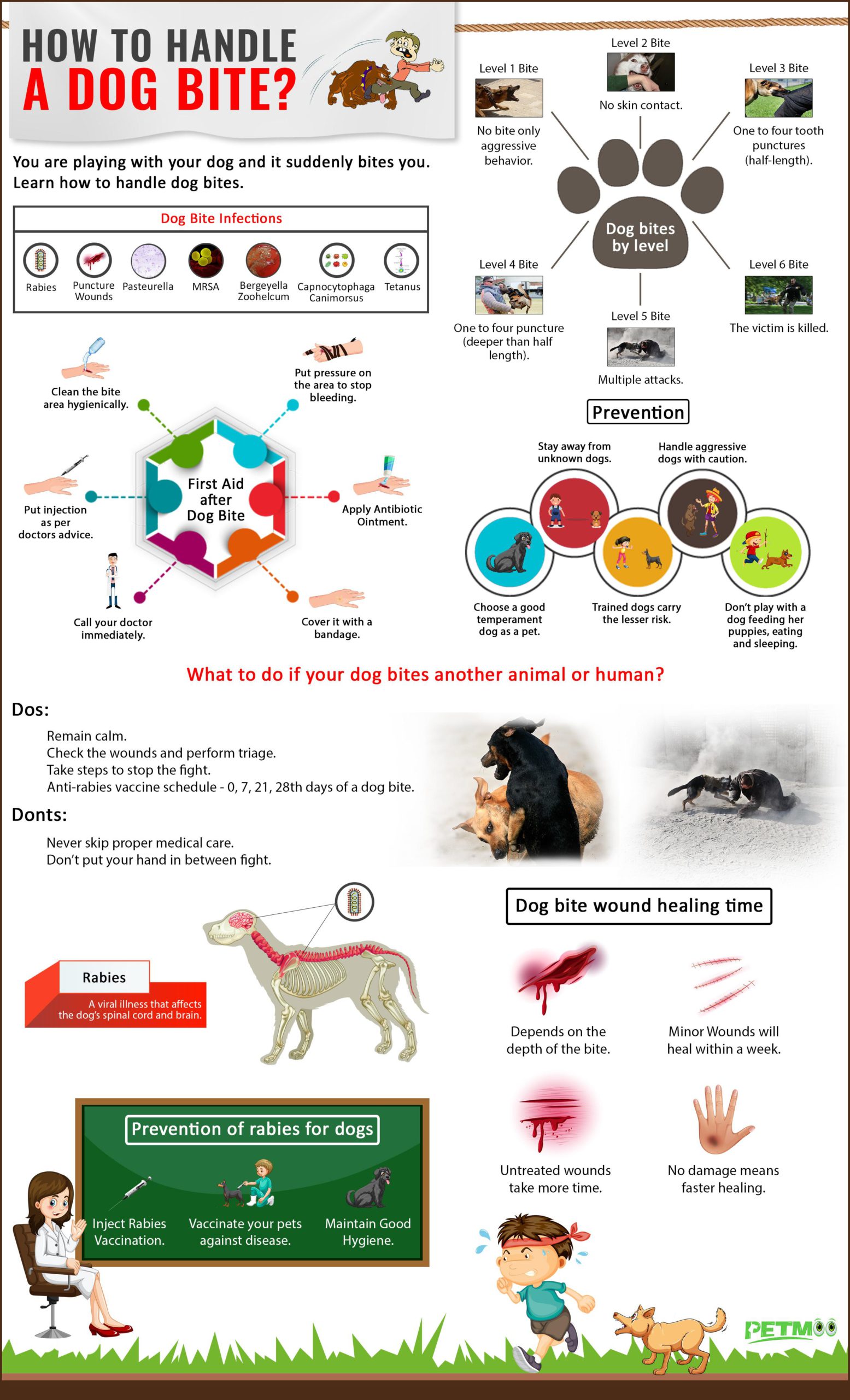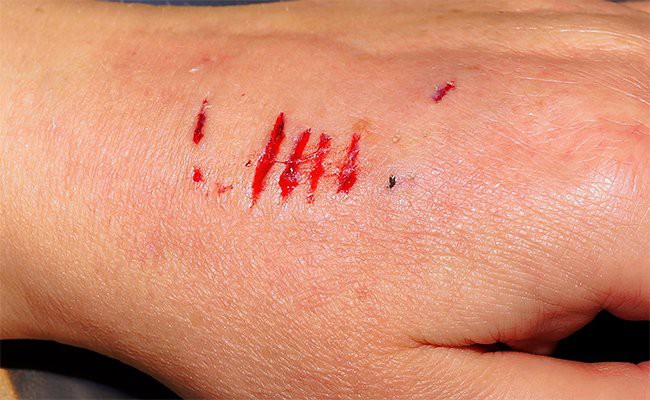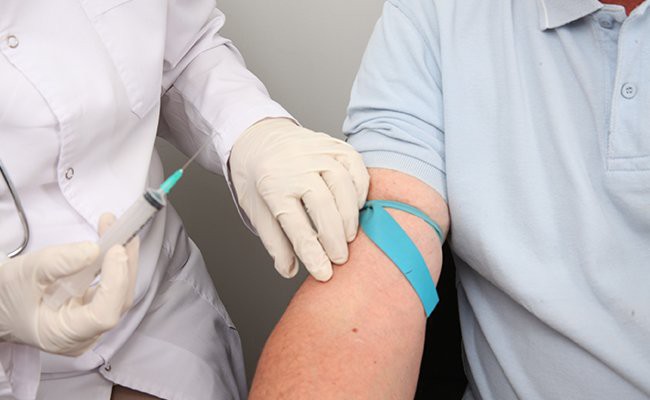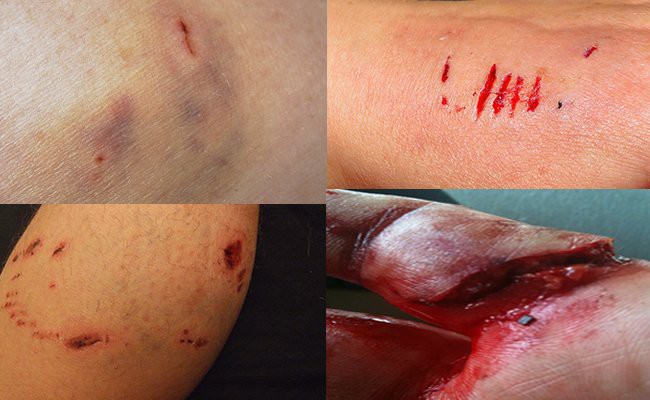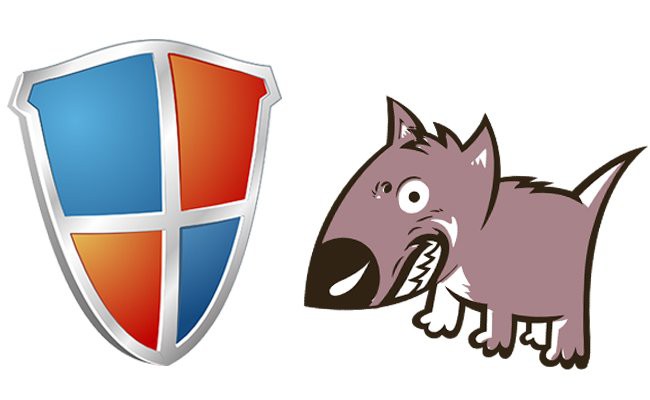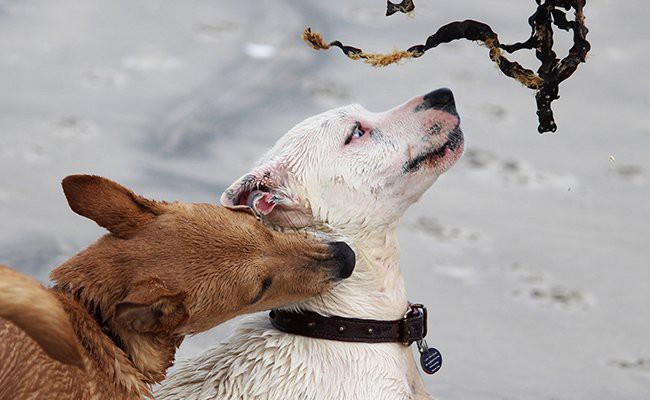- Dog Bite Infographic
- Dog Bite Infections
- Dog Bites Treatment
- Dog Bite Antibiotics
- Dog Bites By Level
- Preventing Dog Bite Infection
- Dog Bites By Breed
- Dog Bite Breed Statistics
- Dog Bite Force Chart
- Preventing Dog Attacks
- Dog Bite Insurance
- Dog Bite On Leg
- Dog Bite On Face
- Dog Bite Lawsuits
- Dog Bite Scar
- Conclusion
- Dog Bites FAQs
Dog Pregnancy Calculator And Timeline
Dogs are man’s best friend, but they can also cause severe injury, especially when they bite.
According to the Centers for Disease Control and Prevention (CDC), approximately 4.7 million dog bites occur in the United States each year, and around 800,000 of those bites require medical attention.
Although many dog bites are not severe, some can cause significant tissue damage, infections, and scarring.
Dog Bite Infections
Dog Bites Treatment
If you are bitten by a dog, it’s crucial to seek medical attention right away. Even if the bite seems minor, it’s essential to get it checked out to ensure that it doesn’t become infected.
Here are the steps to take if you are bitten by a dog:
- Wash the wound with soap and water. Use warm water and mild soap to clean the area thoroughly. If the wound is bleeding, apply pressure with a clean cloth or bandage.
- Apply an antibiotic ointment. Once the wound is clean, apply an over-the-counter antibiotic ointment to prevent infection.
- Cover the wound with a bandage. If the wound is not deep, cover it with a bandage to keep it clean and protected.
- Monitor the wound for signs of infection. Watch for redness, swelling, and warmth around the wound. If you notice any of these symptoms, seek medical attention right away.
Dog Bite Antibiotics
If a dog bite does become infected, your doctor may prescribe antibiotics to treat the infection. The type of antibiotic prescribed will depend on the severity of the infection and the type of bacteria causing it.
Some common antibiotics used to treat dog bites include:
- Penicillin: Penicillin is one of the most commonly prescribed antibiotics for dog bites. It works by preventing bacteria from forming new cell walls, which kills the bacteria.
- Amoxicillin/clavulanate: This is a combination antibiotic that works by killing bacteria and preventing their growth.
- Cephalexin: Cephalexin is a broad-spectrum antibiotic that works by interfering with the bacteria’s ability to form cell walls.
Dog Bites By Level
Level 1 Bite: Aggressive behavior by the dog, not a bite, (i.e.) the dog tries to scare a human or other dog so, they will go away.
Level 2 Bite: No skin puncture by skin contact by teeth. This dog is more aggressive and it wants you to go away from that place.
Level 3 Bite: In a single bite one to four tooth punctures but half the length of the canine teeth.
Level 4 Bite: In a single bite one to four punctures, at least one puncture deeper than half length of canine teeth.
Level 5 Bite: Multiple attacks or multiple bites are not safe for people or other animals.
Level 6 Bite: The victim human or animal is killed. Fortunately, this is rare.
Preventing Dog Bite Infection
The best way to prevent dog bite infections is to avoid getting bitten in the first place. It’s essential to learn how to interact safely with dogs, especially those you don’t know.
Some tips for preventing dog bites include:
- Don’t approach unfamiliar dogs. If you encounter a dog you don’t know, avoid direct eye contact and stand still. Let the dog sniff you, and if it seems friendly, you can slowly reach out your hand to pet it.
- Don’t pet a dog without letting it see and sniff you first. Approaching a dog from behind or reaching out to pet it before it’s aware of your presence can startle the animal and cause it to lash out.
- Don’t disturb a dog that’s sleeping, eating, or caring for puppies. These are times when dogs are more likely to be protective and aggressive.
- Teach children how to interact with dogs safely. Kids should always ask the dog’s owner for permission before approaching a dog, and they should never run up to a dog or disturb it while it’s eating or sleeping.
- Avoid playing rough with dogs. Wrestling or playing tug-of-war with dogs can cause them to become overly excited and aggressive.
- Seek professional help if your dog is aggressive or prone to biting. Some dogs may require professional training or medication to address aggression.
Dog Bites By Breed
Some dog breeds are more prone to biting than others. While it’s important to remember that any dog can bite, certain breeds have a reputation for being more aggressive or prone to biting.
Here are some of the breeds that are commonly associated with dog bites:
- Pit Bulls: Pit bulls are often associated with dog bites and are responsible for a significant percentage of serious injuries and fatalities resulting from dog bites.
- Rottweilers: Rottweilers are another breed that’s often associated with dog bites. They have powerful jaws and strong protective instincts, which can make them aggressive in certain situations.
- German Shepherds: German Shepherds are loyal and protective dogs, but they can also be aggressive if they feel threatened or if they perceive a threat to their family.
- Boxers: Boxers are known for their high energy and playful nature, but they can also become aggressive if they feel threatened or if they perceive a threat to their family.
- Doberman Pinschers: Doberman Pinschers are loyal and protective dogs, but they can also be aggressive if they feel threatened or if they perceive a threat to their family.
Dog Bite Breed Statistics
The American Veterinary Medical Association (AVMA) and the CDC report that certain breeds are responsible for a disproportionate number of dog bites each year.
Here are some of the statistics on dog bite breeds:
- Pit Bulls: Pit bulls account for approximately 70% of all fatal dog attacks in the United States, despite making up only 6% of the dog population.
- Rottweilers: Rottweilers are responsible for approximately 10% of fatal dog attacks, despite making up only 1% of the dog population.
- German Shepherds: German Shepherds are responsible for approximately 5% of fatal dog attacks, despite making up only 3% of the dog population.
- Boxers: Boxers are responsible for approximately 3% of fatal dog attacks, despite making up only 1% of the dog population.
- Huskies: Huskies are responsible for approximately 2% of fatal dog attacks, despite making up only 1% of the dog population.
Dog Bite Force Chart
The force of a dog’s bite can vary widely depending on the breed, size, and strength of the dog. A dog’s bite force is measured in pounds per square inch (PSI), and can range from around 200 PSI for a small dog like a Chihuahua to over 700 PSI for a large dog like a Mastiff.
Here is a dog bite force chart for some common dog breeds:

It’s important to note that a dog’s bite force is just one factor in determining its potential for aggression and danger. Other factors, such as the dog’s temperament, training, and socialization, are also important considerations.
Preventing Dog Attacks
Preventing dog attacks is the responsibility of both dog owners and the general public.
Here are some tips for preventing dog attacks:
- Properly train and socialize your dog: This is one of the most important things you can do to prevent your dog from biting or attacking. Proper training and socialization can help your dog learn how to behave appropriately around people and other animals.
- Keep your dog on a leash: If you’re out in public with your dog, make sure you keep it on a leash at all times. This can prevent your dog from running off and potentially attacking someone.
- Avoid interactions with unfamiliar dogs: If you encounter an unfamiliar dog, avoid approaching it or attempting to pet it. Even if the dog seems friendly, it’s important to exercise caution.
- Supervise children around dogs: Children are often the victims of dog attacks, so it’s important to teach children how to behave around dogs and to always supervise them when they’re interacting with dogs.
Dog Bite Insurance
Dog bite insurance is a type of liability insurance that covers the policyholder in the event of a dog bite or attack.
If you own a dog, it’s a good idea to consider purchasing dog bite insurance to protect yourself financially in case your dog bites someone.
Here are some things to keep in mind when shopping for dog bite insurance:
- Look for a policy that provides adequate coverage: Make sure the policy you choose provides enough coverage to protect you in the event of a serious dog bite or attack. Most policies provide coverage for medical expenses, but some may also provide coverage for legal fees and other related costs.
- Consider the breed of your dog: Some insurance companies may be hesitant to provide coverage for certain breeds of dogs that are considered to be more prone to biting. Be sure to disclose the breed of your dog when shopping for insurance to avoid any issues later on.
- Compare policies and rates: Like any type of insurance, it’s important to compare policies and rates from different providers to find the best coverage at an affordable price.
Dog Bite On Leg
The location of a dog bite can impact the severity of the injury and the risk of infection. Here’s what you need to know about dog bites on the leg.
Dog bites on the leg are common and can range from minor scratches to deep puncture wounds. The biggest risk with leg bites is an infection, as bacteria can easily enter the wound and cause an infection.
If you are bitten on the leg, clean the wound thoroughly with soap and water and seek medical attention if the wound is deep or if you notice any signs of infection.
Dog Bite On Face
Dog bites on the face can be particularly dangerous, as they can cause severe tissue damage and scarring. In addition, the risk of infection is high due to the proximity of the bite to the nose and mouth.
If you are bitten on the face, seek medical attention right away, as prompt treatment can reduce the risk of scarring and infection.
Dog Bite Lawsuits
Dog attacks can be traumatic and life-altering events for victims and their families. If you or a loved one has been bitten or attacked by a dog, you may be entitled to compensation for your injuries and damages.
Here’s what you need to know about dog bite lawsuits and dog bites force charts. In the United States, dog owners can be held liable for injuries and damages caused by their pets.
This is known as strict liability, which means that the owner is responsible for any harm caused by the dog, regardless of whether or not the owner was negligent or knew about the dog’s aggressive tendencies.
However, there are some exceptions to this rule, such as when the victim was trespassing or provoking the dog.
If you’ve been bitten or attacked by a dog, you may be able to file a dog bite lawsuit against the owner to recover damages such as medical expenses, lost wages, and pain and suffering.
To have a successful case, you’ll need to prove that the dog was owned by the defendant, that you were lawfully on the property where the attack occurred, and that you suffered injuries as a result of the attack.
Dog Bite Scar
Even if a dog bite doesn’t cause serious injury, it can still leave a visible scar.
Here are some things to keep in mind if you’re dealing with a dog bite scar:
- Prevention is key: The best way to deal with a dog bite scar is to prevent the bite from happening in the first place. Always approach dogs cautiously and avoid interacting with dogs that appear aggressive or agitated.
- Prompt treatment can reduce scarring: If you are bitten by a dog, seek medical attention right away to reduce the risk of infection and scarring. Proper wound care and stitches, if necessary, can help minimize scarring.
- Treatment options for scars: If you’re dealing with a dog bite scar, there are several treatment options available to help reduce its appearance. These include topical creams, laser therapy, and surgery. Talk to your dermatologist or plastic surgeon to determine the best treatment option for you.
Conclusion
Dog bites can be a serious issue, causing injury, infection, and scarring. However, there are steps you can take to prevent dog bites, including avoiding interactions with aggressive or agitated dogs and properly training and socializing your own dog.
If you are bitten by a dog, seek medical attention right away to reduce the risk of infection and scarring. And if you own a dog, consider purchasing dog bite insurance to protect yourself financially in case your dog bites someone.
By taking these steps, you can help reduce the risk of dog bites and ensure the safety of both humans and dogs.
Dog Bites FAQs
1. What Dog Bites The Most?

The dog breed that bites the most varies depending on the country and region.
In the United States, according to the Centers for Disease Control and Prevention (CDC), the dog breed responsible for the most fatal attacks between 1979 and 1998 was the Pit Bull, with Rottweilers coming in second.
However, it’s important to note that breed-specific statistics can be controversial and are subject to a number of factors, including the popularity of a breed, media coverage, and reporting bias.
2. How Many Dog Bites A Year?
According to the Centers for Disease Control and Prevention (CDC), there are approximately 4.5 million dog bites reported in the United States each year, with an estimated 800,000 of those requiring medical attention.
However, it’s important to note that these figures may not represent the full scope of the issue, as many dog bites go unreported.
The actual number of dog bites may be higher, as some people may not seek medical attention for minor bites or may not report the incident to authorities.
3. Why Dogs Bite Their Tail?
Dogs may bite their tail for a variety of reasons, including medical and behavioral issues. Here are some possible explanations for why a dog may bite its tail:
- Fleas or other parasites: A dog may bite its tail if it is experiencing discomfort or itching due to flea bites or other skin irritations caused by parasites.
- Allergies: Allergies can cause a dog’s skin to become itchy and irritated, leading the dog to bite or chew its tail.
- Anxiety or stress: Some dogs may bite their tail as a self-soothing behavior when they are feeling anxious or stressed.
- Boredom or frustration: Dogs that are not getting enough exercise or mental stimulation may resort to tail-biting as a form of self-amusement or out of frustration.
- Medical issues: Tail-biting can be a symptom of medical conditions such as allergies, infections, or injuries.
4. How Long After Dog Bite To Get Rabies Shot?
The rabies vaccine is given in a series of shots, typically over the course of 14 to 28 days. The exact schedule of the rabies vaccine depends on the type of vaccine used and the severity of the bite.
Here is a common schedule for the rabies vaccine after a dog bite:
- Day 0: The first dose of the rabies vaccine is given as soon as possible after the bite, ideally within 24 hours.
- Days 3, 7, and 14: Additional doses of the rabies vaccine are given on days 3, 7, and 14 after the first dose.
In some cases, additional doses of the vaccine may be recommended depending on the severity of the bite and other factors.
It’s important to follow the recommended schedule of the rabies vaccine to ensure that you are protected against the disease.
Even if you have been vaccinated against rabies before, you may still need to receive the vaccine again if you are bitten by an animal that may have the disease.
5. Does Dog Bite Cause Rabies?
Yes, a dog bite can cause rabies if the dog is infected with the virus. Rabies is a viral disease that affects the nervous system and is spread through the saliva of infected animals.
However, not all dogs carry rabies, and even if a dog is infected, it does not necessarily mean that a bite will result in rabies transmission. If you are bitten by a dog, it’s important to seek medical attention right away.
Your doctor can evaluate the bite and determine whether rabies treatment is necessary. If the dog is suspected of carrying rabies, you may need to receive a series of shots to prevent the onset of the disease.


